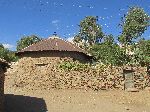|
Ethiopia: Abyssinia Adventure - Axum Bicycle Africa / Ibike Tours |
|||
 |
Axum is the original capital of the Kingdom of Aksum, it is one of the oldest continuously inhabited places in Africa. Axum was a naval and trading power that ruled the region from about 400 BCE into the 10th century. The Aksumite rulers facilitated trade by minting their own Aksumite currency, the state established its hegemony over the declining Kingdom of Kush (upper Nile Valley) and regularly entered the politics of the kingdoms on the Arabian Peninsula, eventually extending its rule over the region with the conquest of the Himyarite Kingdom (ancient Yemen). At its height the territory extended from the southwest Arabian Penninsula to the White Nile River and Upper Nile River. | ||
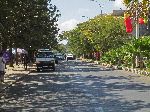 |
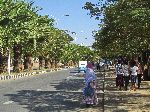 Axum
has benefited greatly from the national initiative to improve urban
infrastructure. That is not to say that the power will stay on for twenty-four
hours straight, but the electric service is improved, the roads and sidewalks
are in good condition, the central town has street trees that greatly improve
the quality of life. there is a new university in town (2004) and economic
vitality has returned to the town, especially when tourism is good. The many
business of Axum is tourism. Axum
has benefited greatly from the national initiative to improve urban
infrastructure. That is not to say that the power will stay on for twenty-four
hours straight, but the electric service is improved, the roads and sidewalks
are in good condition, the central town has street trees that greatly improve
the quality of life. there is a new university in town (2004) and economic
vitality has returned to the town, especially when tourism is good. The many
business of Axum is tourism.The two star attractions are St Mary's Cathedral
and the stelea field across the street. |
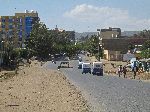 |
|
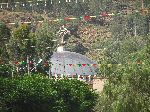 |
The Old St Mary of Zion Cathedral was built in 1665 by Emperor Fasilides and
said to have previously housed the Ark of the Covenant. Only males are permitted
entry into the Old St. Mary's Cathedral (some say as a result of the destruction
of the original church by Gudit). The New Cathedral of St. Mary of Zion stands next to the old one, and was built to fulfill a pledge by Emperor Haile Selassie to Our Lady of Zion for the liberation of Ethiopia from the Fascist occupation. Built in a neo-Byzantine style, work on the new cathedral began in 1955, and allows admittance to women. Emperor Haile Selassie interrupted the state visit of Britain's Queen Elizabeth II to travel to Axum to attend the dedication of the new Cathedral and pay personal homage, showing the importance of this church in the Ethiopian Empire. The Queen visited the Cathedral a few days later. St. Mary of Zion was the traditional place where Ethiopian Emperors came to
be crowned. |
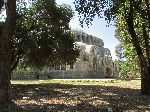 |
|
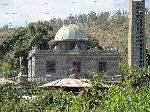 |
Between the two cathedrals is a small chapel known as The Chapel of the Tablet
(left) built at the same time as the new cathedral, and which is believed to house the
Ark of the Covenant. Emperor Haile Selassie's consort, Empress Menen, paid for
its construction from her private funds. Admittance to the chapel is closed to
all but the guardian monk who resides there. Entrance is even forbidden to the
Patriarch of the Orthodox Church, and to the Emperor of Ethiopia during the
monarchy. According to tradition, the Ark came to Ethiopia with Menelik I
after he visited his father King Solomon. Only the guardian monk may view the
Ark, in accordance with the Biblical accounts of the dangers of doing so for
non-Kohanim. This lack of accessibility, and questions about the account as a
whole, has led foreign scholars to express doubt about the veracity of the
claim. The guardian monk is appointed for life by his predecessor before the
predecessor dies. If the incumbent guardian dies without naming a successor,
then the monks of the monastery hold an election to select the new guardian. The
guardian then is confined to the chapel of the Ark of the Covenant for the rest
of his life, praying before it and offering incense. |
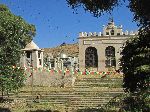 |
|
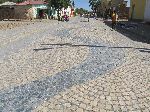 |
The two cathedrals and the chapel of the Ark are the focus of pilgrimage and
considered the holiest sites in Ethiopia to members of its Orthodox Church,
especially during the main Festival of Zion Maryam on 30 November (21 Hidar on
the Ethiopian calendar). Around the St. Mary complex the streets have been
paved with cobbles, inlayed with a blue wave design (left) and there is a new
tourism and culture center being readied (2016) (right) |
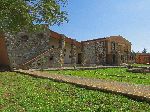 |
|
|
The Ezana stone is an artifact from the ancient Kingdom of Aksum. It is a stone
monument which documents the conversion of King Ezana to Christianity and his
subjugation of various neighboring areas, including Meroë. From AD 330 to 356, King Ezana ruled the ancient Aksumite kingdom in the Horn of Africa. He fought against the Nubians and recorded his victories on stone written in Ge'ez (the ancient Eritrean/Ethiopian language), Sabaean (South Arabian) and Greek praising God for his victories. His carvings in stone provided a trilingual monument in different languages, similar to the Rosetta stone. The Ethiopian Orthodox Tewahedo Church had its beginnings during
this period. Rufinus's Ecclesiastical History narrates that Saint
Frumentius, a slave and tutor for the very young King, converted him to
Christianity. Towards the end of his reign, King Ezana launched a campaign
against the Kushites around 350 which brought down the Kingdom of Kush. Various
stone inscriptions written in Ge'ez (using the Ge'ez script) have been found at
Meroë, the central city of the Kushites. |
|||
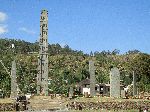 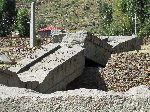 The
Axumites erected a number of large stelae, which served a religious purpose in
pre-Christian times and to mark burial chambers beneath them. One of these
granite columns is the largest such structure in the world, standing at 90 feet,
but has since fallen (right). The
Axumites erected a number of large stelae, which served a religious purpose in
pre-Christian times and to mark burial chambers beneath them. One of these
granite columns is the largest such structure in the world, standing at 90 feet,
but has since fallen (right). |
|||
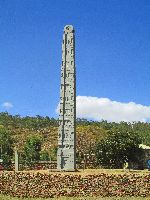 |
One of the most famous stele is the Obelisk of Axum (left), a 1,700-year-old, 24-metre-tall (79-foot) granite
stele/obelisk, weighing 160 tons. It is ornamented with two false doors at the
base and features decorations resembling windows on all sides. The obelisk ends
in a semi-circular top part, which used to be enclosed by metal frames. The Obelisk of Axum was found collapsed and broken by Italian soldiers at the end of 1935, following the Italian conquest of Ethiopia. It had fallen in the 4th century and had broken into five pieces. In 1937, it was taken as war booty and moved to Italy by the Fascist regime, which wanted to commemorate the conquest of Ethiopia and the birth of the ephemeral "new Roman Empire". The stele which were transported by truck along the tortuous route between Axum and the port of Massawa (Eritrea), taking five trips over a period of two months. It arrived via ship in Naples on March 27, 1937. It was then transported to Rome, where it was reassembled and erected on Porta Capena square in front of the Ministry for Italian Africa (later the headquarters of the United Nations's Food and Agriculture Organization) and the Circus Maximus. It was officially unveiled on October 28, 1937 to commemorate the 15th anniversary of the March on Rome. In a 1947 UN agreement, Italy agreed to return the stele to Ethiopia, along with the other looted piece, the Lion of Judah. While the latter was returned to Addis Ababa, in 1967, following the 1961 visit of emperor Haile Selassie to Italy, little action was taken to return the stele for more than 50 years, partly as a consequence of the considerable cost and technical difficulties related to its transportation. After the fall of the Mengistu regime (1991), the new Ethiopian government asked for the return of the stele, finding a positive answer from the then president of the Italian republic Oscar Luigi Scalfaro, in April 1997. The first steps in dismantling the structure were taken in November 2003, with the intent to ship the stele back to Ethiopia in March 2004. However, the repatriation project encountered a series of obstacles: The runway at Axum Airport was considered too short for a cargo plane carrying even one of the thirds into which the stele had been cut; the roads and bridges between Addis Ababa and Axum were thought to be not up to the task of road transport; and access through the nearby Eritrean port of Massawa — which was how the stele originally left Africa — was impossible due to the strained state of relations between Eritrea and Ethiopia. The runway at Axum airport was then upgraded specially to facilitate the
return of the stele. The dismantled stele remained sitting in a warehouse near
Rome's Leonardo Da Vinci International Airport, until 19 April 2005 when the
middle piece was repatriated by use of an Antonov An-124, amidst much local
celebration. It was the largest and heaviest piece of air freight ever carried.
The second piece was returned on 22 April 2005, with the final piece returned on
25 April 2005. The operation cost Italy $7.7 million. The stele remained in
storage while Ethiopia decided how to reconstruct it without disturbing other
ancient treasures still in the area (especially King Ezana's Stele, which is
leaning). By March
2007 the foundation had been poured for the re-erection of the stele near King Ezana's Stele, structurally consolidated in this occasion. Reassembly began in
June 2008, with a team chosen by UNESCO and led by Italian engineer Giorgio
Croci (who had also surveyed its dismantling in 2003) and the monument was
resurrected in its original home and unveiled on 4 September 2008. |
||
|
South of the stelea is
Dungur, known locally and popularly as the Palace of the Queen of Sheba (i.e.
the Palace of Makeda in Ethiopia). However, Stuart Munro-Hay describes it
as "the sort of dwelling that a prosperous Aksumite, perhaps a noble or high
official of the fourth to sixth centuries AD, might have constructed for
himself. |
|||
|
Other attractions in Axum include archaeological and ethnographic museums,
King Bazen's Tomb (a megalith
considered to be one of the earliest structures), the so-called
Queen of Sheba's Bath (actually a
reservoir), the 4th-century
Ta'akha Maryam and the monasteries of
Abba Pentalewon and
Abba Liqanos and the
Lioness of Gobedra rock art. |
|||
 |
A couple of indications that there is a normal economy in Axum: The is a trickle of bicycle traffic on Axum streets. This bicyclist was cruising down the road carrying a ladder. A cinema is called the Seatle Cinema, but there is no indication of a direct connection. |
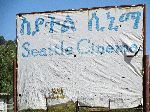 |
|
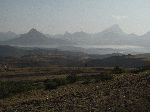
An early morning view from Axum of the mountains east of Axum. |
|||
|
|
|||
|
|
Unique Programs To Special Places For Memories Of A Lifetime!
"Hosted by
DreamHost - earth friendly web hosting"
|
|
